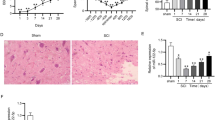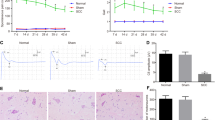Abstract
Currently, there is no cure for spinal cord injury (SCI), a heavy burden on patients physiology and psychology. We found that microRNA-139-5p (miR-139-5p) expression was significantly downregulated in damaged spinal cords in mice. So, we aimed to test the effect of treatment with miR-139-5p on functional recovery and neuropathic pain in mice with SCI and investigate the underlying mechanism. The luciferase reporter assay revealed that miR-139-5p directly targeted mammalian sterile 20-like kinase 1 (Mst1), and miR-139-5p treatment suppressed Mst1 protein expression in damaged spinal cords of mice. Wild-type mice and Mst1(−/−) mice were exposed to SCI and treated with miR-139-5p agomir via intrathecal infusion. Treatment of SCI mice with miR-139-5p accelerated locomotor functional recovery, reduced hypersensitivities to mechanical and thermal stimulations, and promoted neuronal survival in damaged spinal cords. Treatment with miR-139-5p enhanced phosphorylation of adenosine monophosphate-activated protein kinase alpha (AMPKα), improved mitochondrial function, and suppressed NF-κB-related inflammation in damaged spinal cords. Deficiency of Mst1 had similar benefits in mice with SCI. Furthermore, miR-139-5p treatment did not provide further protection in Mst1(−/−) mice against SCI. In conclusion, miR-139-5p treatment enhanced functional recovery and reduced pain hypersensitivity in mice with SCI, possibly through targeting Mst1.






Similar content being viewed by others
References
Friedli L, Rosenzweig ES, Barraud Q, Schubert M, Dominici N, Awai L, Nielson JL, Musienko P, Nout-Lomas Y, Zhong H, Zdunowski S, Roy RR, Strand SC, van den Brand R, Havton LA, Beattie MS, Bresnahan JC, Bézard E, Bloch J, Edgerton VR, Ferguson AR, Curt A, Tuszynski MH, Courtine G (2015) Pronounced species divergence in corticospinal tract reorganization and functional recovery after lateralized spinal cord injury favors primates. Sci Transl Med 7:302ra134. https://doi.org/10.1126/scitranslmed.aac5811
Li HL, Xu H, Li YL, Sun SW, Song WY, Wu Q, Ai J, Sun JC, Ning GZ, Feng SQ (2019) Epidemiology of traumatic spinal cord injury in Tianjin, China: an 18-year retrospective study of 735 cases. J Spinal Cord Med 42:778–785. https://doi.org/10.1080/10790268.2017.1415418
Kwon BK, Bloom O, Wanner IB, Curt A, Schwab JM, Fawcett J, Wang KK (2019) Neurochemical biomarkers in spinal cord injury. Spinal Cord 57:819–831. https://doi.org/10.1038/s41393-019-0319-8
Ambros V (2004) The functions of animal microRNAs. Nature 431:350–355. https://doi.org/10.1038/nature02871
Bartel DP (2004) MicroRNAs: genomics, biogenesis, mechanism, and function. Cell 116:281–297. https://doi.org/10.1016/s0092-8674(04)00045-5
Hatfield S, Ruohola-Baker H (2008) microRNA and stem cell function. Cell Tissue Res 331:57–66. https://doi.org/10.1007/s00441-007-0530-3
Gauthier BR, Wollheim CB (2006) MicroRNAs: ‘ribo-regulators’ of glucose homeostasis. Nat Med 12:36–38. https://doi.org/10.1038/nm0106-36
Sun P, Liu DZ, Jickling GC, Sharp FR, Yin KJ (2018) MicroRNA-based therapeutics in central nervous system injuries. J Cereb Blood Flow Metab 38:1125–1148. https://doi.org/10.1177/0271678X18773871
Nieto-Diaz M, Esteban FJ, Reigada D, Muñoz-Galdeano T, Yunta M, Caballero-López M, Navarro-Ruiz R, Del Águila A, Maza RM (2014) MicroRNA dysregulation in spinal cord injury: causes, consequences and therapeutics. Front Cell Neurosci 8:53. https://doi.org/10.3389/fncel.2014.00053
Qu Y, Wu J, Chen D, Zhao F, Liu J, Yang C, Wei D, Ferriero DM, Mu D (2014) MiR-139-5p inhibits HGTD-P and regulates neuronal apoptosis induced by hypoxia-ischemia in neonatal rats. Neurobiol Dis 63:184–193. https://doi.org/10.1016/j.nbd.2013.11.023
Wang L, Song L, Chen X, Suo J, Ma Y, Shi J, Liu K, Chen G (2020) microRNA-139-5p confers sensitivity to antiepileptic drugs in refractory epilepsy by inhibition of MRP1. CNS Neurosci Ther 26:465–474. https://doi.org/10.1111/cns.13268
Jakeman LB, Guan Z, Wei P, Ponnappan R, Dzwonczyk R, Popovich PG, Stokes BT (2000) Traumatic spinal cord injury produced by controlled contusion in mouse. J Neurotrauma 17:299–319. https://doi.org/10.1089/neu.2000.17.299
Kaushik MK, Aritake K, Imanishi A, Kanbayashi T, Ichikawa T, Shimizu T, Urade Y, Yanagisawa M (2018) Continuous intrathecal orexin delivery inhibits cataplexy in a murine model of narcolepsy. Proc Natl Acad Sci USA 115:6046–6051. https://doi.org/10.1073/pnas.1722686115
Liu R, Wang W, Wang S, Xie W, Li H, Ning B (2018) microRNA-21 regulates astrocytic reaction post-acute phase of spinal cord injury through modulating TGF-β signaling. Aging (Albany NY) 10:1474–1488. https://doi.org/10.18632/aging.101484
Basso DM, Fisher LC, Anderson AJ, Jakeman LB, McTigue DM, Popovich PG (2006) Basso Mouse Scale for locomotion detects differences in recovery after spinal cord injury in five common mouse strains. J Neurotrauma 23:635–659. https://doi.org/10.1089/neu.2006.23.635
Peng W, Cotrina ML, Han X, Yu H, Bekar L, Blum L, Takano T, Tian GF, Goldman SA, Nedergaard M (2009) Systemic administration of an antagonist of the ATP-sensitive receptor P2X7 improves recovery after spinal cord injury. Proc Natl Acad Sci USA 106:12489–12493. https://doi.org/10.1073/pnas.0902531106
Martucci C, Trovato AE, Costa B, Borsani E, Franchi S, Magnaghi V, Panerai AE, Rodella LF, Valsecchi AE, Sacerdote P, Colleoni M (2008) The purinergic antagonist PPADS reduces pain related behaviours and interleukin-1 beta, interleukin-6, iNOS and nNOS overproduction in central and peripheral nervous system after peripheral neuropathy in mice. Pain 137:81–95. https://doi.org/10.1016/j.pain.2007.08.017
Hargreaves K, Dubner R, Brown F, Flores C, Joris J (1988) A new and sensitive method for measuring thermal nociception in cutaneous hyperalgesia. Pain 32:77–88. https://doi.org/10.1016/0304-3959(88)90026-7
Hoschouer EL, Basso DM, Jakeman LB (2010) Aberrant sensory responses are dependent on lesion severity after spinal cord contusion injury in mice. Pain 148:328–342. https://doi.org/10.1016/j.pain.2009.11.023
Chinda K, Sanit J, Chattipakorn S, Chattipakorn N (2014) Dipeptidyl peptidase-4 inhibitor reduces infarct size and preserves cardiac function via mitochondrial protection in ischaemia-reperfusion rat heart. Diab Vasc Dis Res 11:75–83. https://doi.org/10.1177/1479164113516134
Wang Y, Li X, Wang X, Lau W, Wang Y, Xing Y, Zhang X, Ma X, Gao F (2013) Ginsenoside Rd attenuates myocardial ischemia/reperfusion injury via Akt/GSK-3β signaling and inhibition of the mitochondria-dependent apoptotic pathway. PLoS One 8:e70956. https://doi.org/10.1371/journal.pone.0070956
Patel SP, Sullivan PG, Pandya JD, Rabchevsky AG (2009) Differential effects of the mitochondrial uncoupling agent, 2,4-dinitrophenol, or the nitroxide antioxidant, Tempol, on synaptic or nonsynaptic mitochondria after spinal cord injury. J Neurosci Res 87:130–140. https://doi.org/10.1002/jnr.21814
Sullivan PG, Dube C, Dorenbos K, Steward O, Baram TZ (2003) Mitochondrial uncoupling protein-2 protects the immature brain from excitotoxic neuronal death. Ann Neurol 53:711–717. https://doi.org/10.1002/ana.10543
Meng Z, Moroishi T, Mottier-Pavie V, Plouffe SW, Hansen CG, Hong AW, Park HW, Mo JS, Lu W, Lu S, Flores F, Yu FX, Halder G, Guan KL (2015) MAP4K family kinases act in parallel to MST1/2 to activate LATS1/2 in the Hippo pathway. Nat Commun 6:8357. https://doi.org/10.1038/ncomms9357
Graves JD, Gotoh Y, Draves KE, Ambrose D, Han DK, Wright M, Chernoff J, Clark EA, Krebs EG (1998) Caspase-mediated activation and induction of apoptosis by the mammalian Ste20-like kinase Mst1. EMBO J 17:2224–2234. https://doi.org/10.1093/emboj/17.8.2224
Qu J, Zhao H, Li Q, Pan P, Ma K, Liu X, Feng H, Chen Y (2018) MST1 Suppression reduces early brain injury by inhibiting the NF-κB/MMP-9 pathway after subarachnoid hemorrhage in mice. Behav Neurol 2018:6470957. https://doi.org/10.1155/2018/6470957
Zhang P, Wang T, Zhang D, Zhang Z, Yuan S, Zhang J, Cao J, Li H, Li X, Shen H, Chen G (2019) Exploration of MST1-mediated secondary brain injury induced by intracerebral hemorrhage in rats via hippo signaling pathway. Transl Stroke Res 10:729–743. https://doi.org/10.1007/s12975-019-00702-1
Li D, Ni H, Rui Q, Gao R, Chen G (2018) Deletion of Mst1 attenuates neuronal loss and improves neurological impairment in a rat model of traumatic brain injury. Brain Res 1688:15–21. https://doi.org/10.1016/j.brainres.2017.10.018
Zhang M, Tao W, Yuan Z, Liu Y (2017) Mst-1 deficiency promotes post-traumatic spinal motor neuron survival via enhancement of autophagy flux. J Neurochem 143:244–256. https://doi.org/10.1111/jnc.14154
Wang PF, Xu DY, Zhang Y, Liu XB, Xia Y, Zhou PY, Fu QG, Xu SG (2017) Deletion of mammalian sterile 20-like kinase 1 attenuates neuronal loss and improves locomotor function in a mouse model of spinal cord trauma. Mol Cell Biochem 431:11–20. https://doi.org/10.1007/s11010-017-2969-1
Xie C, Shen X, Xu X, Liu H, Li F, Lu S, Gao Z, Zhang J, Wu Q, Yang D, Bao X, Zhang F, Wu S, Lv Z, Zhu M, Xu D, Wang P, Cao L, Wang W, Yuan Z, Wang Y, Li Z, Teng H, Huang Z (2020) Astrocytic YAP promotes the formation of glia scars and neural regeneration after spinal cord injury. J Neurosci 40:2644–2662. https://doi.org/10.1523/JNEUROSCI.2229-19.2020
Scholpa NE, Schnellmann RG (2017) Mitochondrial-based therapeutics for the treatment of spinal cord injury: mitochondrial biogenesis as a potential pharmacological target. J Pharmacol Exp Ther 363:303–313. https://doi.org/10.1124/jpet.117.244806
O’Brien LC, Wade RC, Segal L, Chen Q, Savas J, Lesnefsky EJ, Gorgey AS (2017) Mitochondrial mass and activity as a function of body composition in individuals with spinal cord injury. Physiol Rep 5:e13080. https://doi.org/10.14814/phy2.13080
Wu SB, Wu YT, Wu TP, Wei YH (2014) Role of AMPK-mediated adaptive responses in human cells with mitochondrial dysfunction to oxidative stress. Biochim Biophys Acta 1840:1331–1344. https://doi.org/10.1016/j.bbagen.2013.10.034
Wang C, Wang Q, Lou Y, Xu J, Feng Z, Chen Y, Tang Q, Zheng G, Zhang Z, Wu Y, Tian N, Zhou Y, Xu H, Zhang X (2018) Salidroside attenuates neuroinflammation and improves functional recovery after spinal cord injury through microglia polarization regulation. J Cell Mol Med 22:1148–1166. https://doi.org/10.1111/jcmm.13368
Herzig S, Shaw RJ (2018) AMPK: guardian of metabolism and mitochondrial homeostasis. Nat Rev Mol Cell Biol 19:121–135. https://doi.org/10.1038/nrm.2017.95
Wang Y, An H, Liu T, Qin C, Sesaki H, Guo S, Radovick S, Hussain M, Maheshwari A, Wondisford FE, O’Rourke B, He L (2019) Metformin improves mitochondrial respiratory activity through activation of AMPK. Cell Rep 29:1511-1523.e5. https://doi.org/10.1016/j.celrep.2019.09.070
Xu J, Wu L, Zhang Y, Gu H, Huang Z, Zhou K, Yin X (2017) Activation of AMPK by OSU53 protects spinal cord neurons from oxidative stress. Oncotarget 8:112477–112486. https://doi.org/10.18632/oncotarget.22055
Yao S, Yan W (2018) Overexpression of Mst1 reduces gastric cancer cell viability by repressing the AMPK-Sirt3 pathway and activating mitochondrial fission. Onco Targets Ther 11:8465–8479. https://doi.org/10.2147/OTT.S180851
Feng J, Li H, Zhang Y, Wang Q, Zhao S, Meng P, Li J (2018) Mammalian STE20-like kinase 1 deletion alleviates renal ischaemia-reperfusion injury via modulating mitophagy and the AMPK-YAP signalling pathway. Cell Physiol Biochem 51:2359–2376. https://doi.org/10.1159/000495896
Orr MB, Gensel JC (2018) Spinal cord injury scarring and inflammation: therapies targeting glial and inflammatory responses. Neurotherapeutics 15:541–553. https://doi.org/10.1007/s13311-018-0631-6
Grilli M, Memo M (1999) Nuclear factor-kB/Rel proteins: a point of convergence of signalling pathways relevant in neuronal function and dysfunction. Biochem Pharmacol 57:1–7. https://doi.org/10.1016/s0006-2952(98)00214-7
Kanngiesser M, Häussler A, Myrczek T, Küsener N, Lim HY, Geisslinger G, Niederberger E, Tegeder I (2012) Inhibitor kappa B kinase beta dependent cytokine upregulation in nociceptive neurons contributes to nociceptive hypersensitivity after sciatic nerve injury. J Pain 13:485–497. https://doi.org/10.1016/j.jpain.2012.02.010
Zhao S, Yin J, Zhou L, Yan F, He Q, Huang L, Peng S, Jia J, Cheng J, Chen H, Tao W, Ji X, Xu Y, Yuan Z (2016) Hippo/MST1 signaling mediates microglial activation following acute cerebral ischemia-reperfusion injury. Brain Behav Immun 55:236–248. https://doi.org/10.1016/j.bbi.2015.12.016
Acknowledgements
This work was supported by grants from Planned Science and Technology Project of Suzhou city (SS201611 to Yongming Sun).
Author information
Authors and Affiliations
Corresponding author
Ethics declarations
Conflict of interest
The authors declare that they have conflict of interest.
Additional information
Publisher's Note
Springer Nature remains neutral with regard to jurisdictional claims in published maps and institutional affiliations.
Rights and permissions
About this article
Cite this article
Wang, P., Zhang, Y., Xia, Y. et al. MicroRNA-139-5p Promotes Functional Recovery and Reduces Pain Hypersensitivity in Mice with Spinal Cord Injury by Targeting Mammalian Sterile 20-like Kinase 1. Neurochem Res 46, 349–357 (2021). https://doi.org/10.1007/s11064-020-03170-4
Received:
Revised:
Accepted:
Published:
Issue Date:
DOI: https://doi.org/10.1007/s11064-020-03170-4




